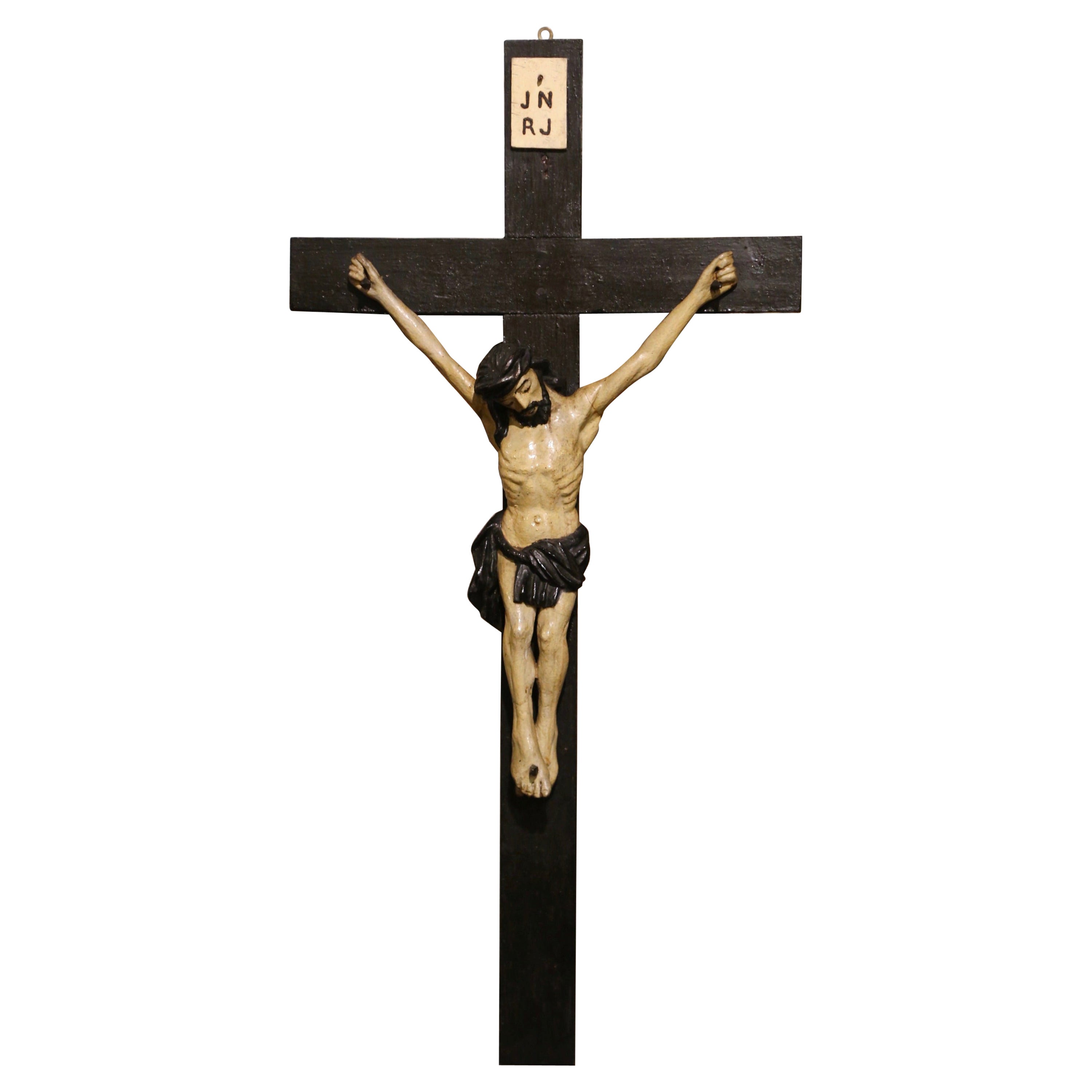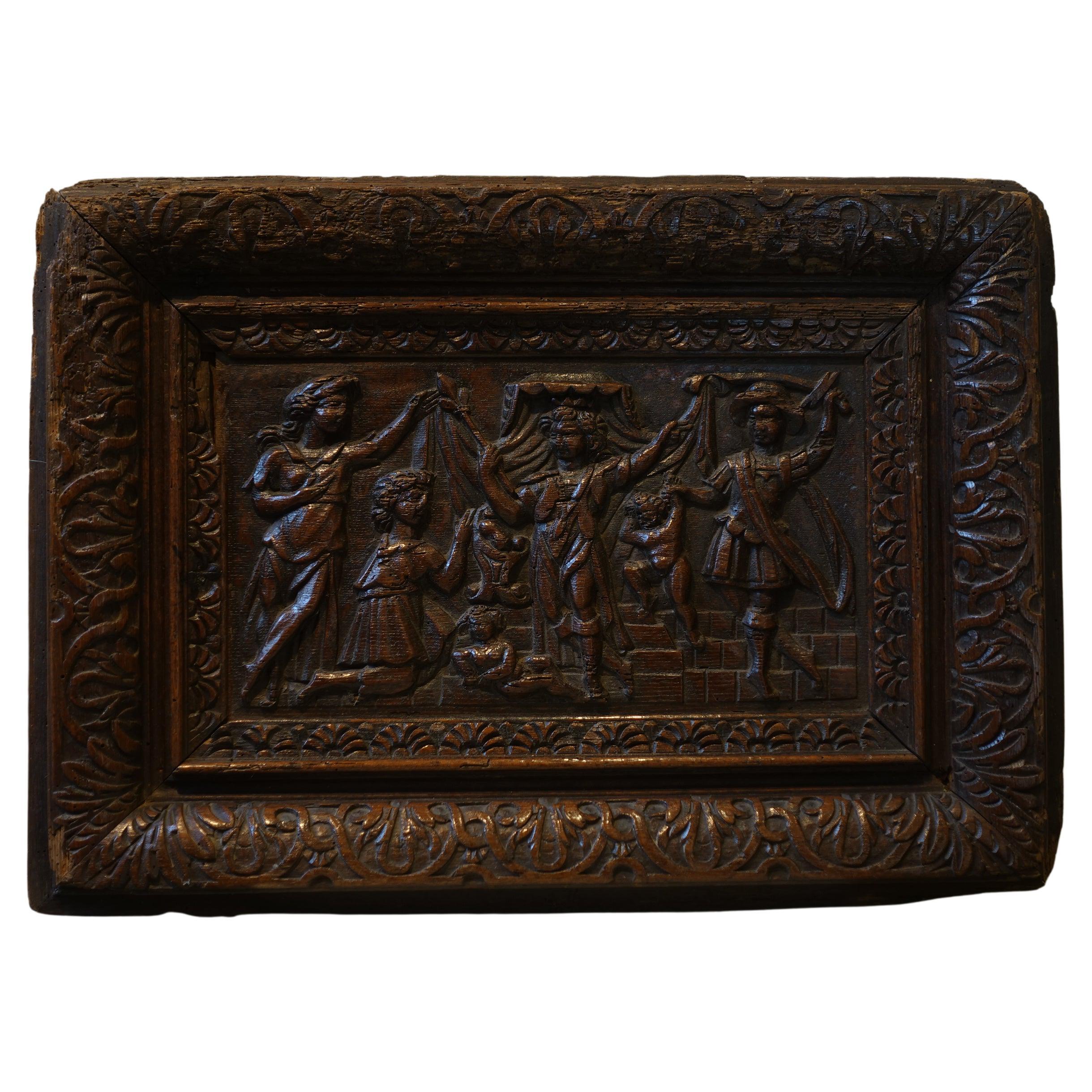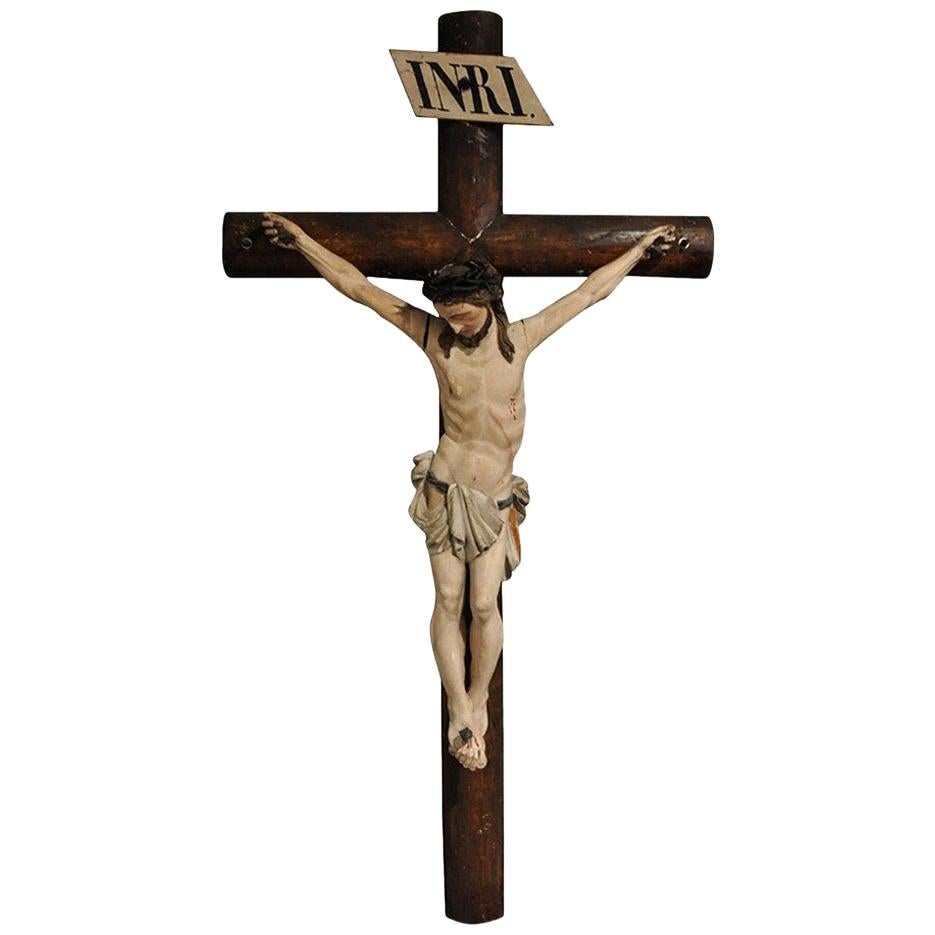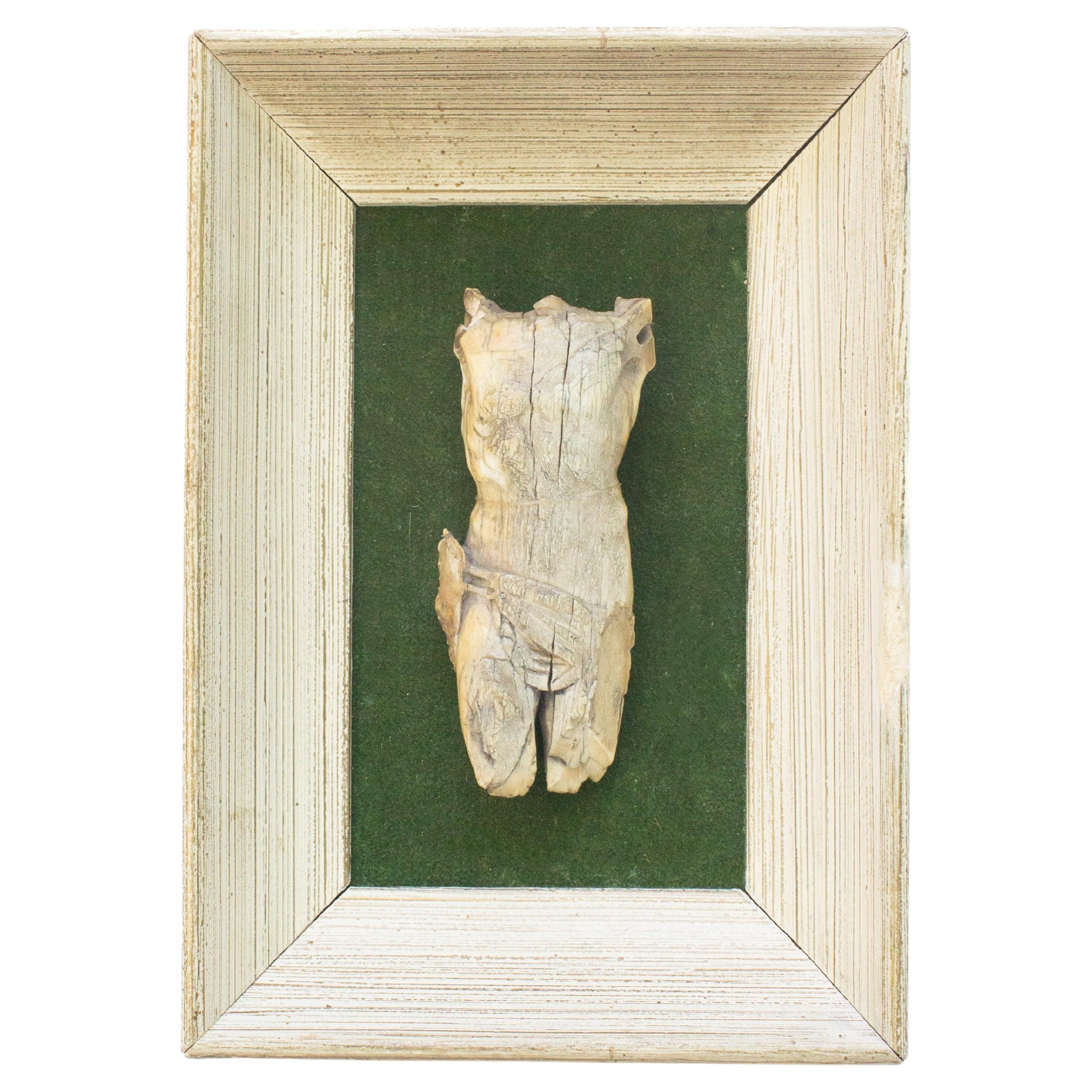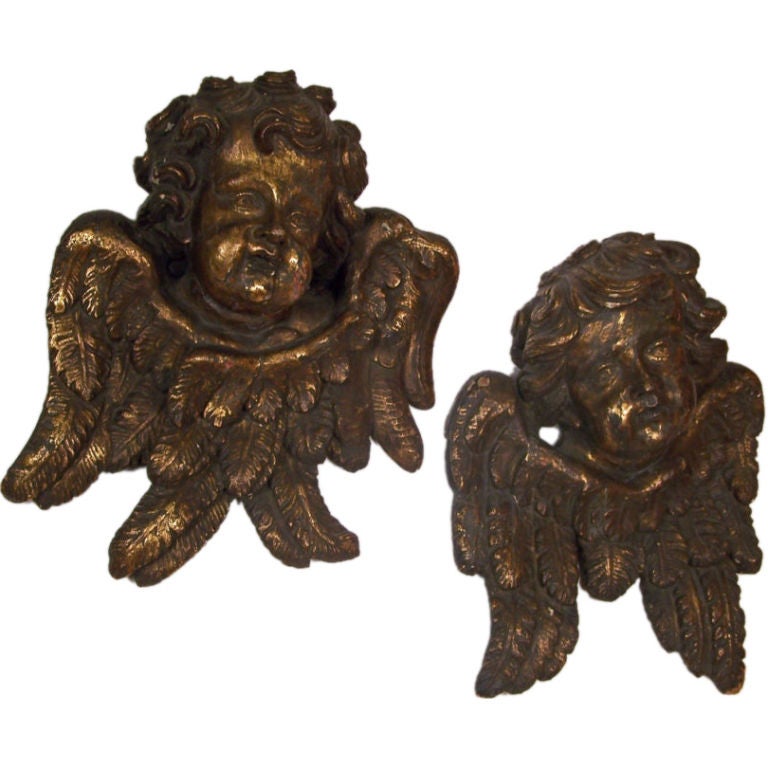Items Similar to Saints John and Matthew, Polychrome Wood, Possibly, Burgos School, 16th Century
Want more images or videos?
Request additional images or videos from the seller
1 of 19
Saints John and Matthew, Polychrome Wood, Possibly, Burgos School, 16th Century
About the Item
Pair of reliefs, San Juan and San Mateo. Polychrome wood. Possibly, Burgos school, 16th century.
Pair of carved and polychrome wood reliefs that each show a seated human figure writing, surrounded by books and accompanied by a figure respectively. One, with black hair and a beard, appears accompanied by another winged child figure who brings him an inkwell; the second, younger (beardless) and with blond hair, is shown concentrating on a scroll, while an eagle brings him an inkwell with one leg, leaning on one of them.
As corresponds to this type of theme, each one of the Evangelists usually appears accompanied by the corresponding figure of the four that make up the Tetramorph. Thus, Saint John is shown with the eagle and Saint Matthew with the "winged man." Both are shown surrounded by books, in two interiors decorated with gilded furniture and seated on high-backed chairs or thrones. Note the vegetal scrolls of the books, furniture and walls, accompanied by elements of candelieri and fish or dolphin heads, in compositions reminiscent of those found in Renaissance works. This classicist influence can also be seen in the figures (faces, folds, anatomy, posture, etc.) and in the environment they occupy (for example, the moldings and scrolls of the seats and desks, or the aforementioned decoration of the bindings of the books that appear in both works).
The iconography that appears in this couple is frequent in the Spanish art of the time, often located in the lower part of the altarpieces (Altarpiece of Foncea, Burgos school). Compare, for example, with the Saint John the Evangelist in the Altarpiece of the Assumption of Ullíbarri Viña (execution attributed to Juan de Ayala II, painted before 1579 by Juan de Oñate) in the Basque Country, where three books also appear in a mezzanine From the bottom; or, to see a different composition, with the set of four Evangelists attributed to Felipe Bigarny (dated between 1501 and 1525) from the Castilian school of the National Sculpture Museum (Valladolid); or with the relief of San Marcos from the altarpiece of Santa Eulalia de Markinez or Marquinez of the Diocesan Museum of Sacred Art of Vitoria-Gasteiz (attributed its sculpture to the workshop of Juan de Ayala II and the polychrome to Santos Corres, dated in the second half of the 16th century sculpture and polychrome in 1747). In addition to Felipe Vigarny, in Burgos surroundings it is necessary to take into account Bartolomé Ordóñez and Diego de Siloé (two of the most important names of the first third of the 16th century), along with teachers such as Juan de Balmaseda, Andrés de Nájera, Juan de Juni (he also worked in the city), etc."
Size: 72 x 4 x 99 cm. Weight is orientative.
International buyers – Please Note: for those articles that need Export Permits (those older than 100 years), the obtaining of the Permit will be processed without additional expenses, but the period for the obtention of it may vary from 10 to 35 days.
- Dimensions:Height: 38.98 in (99 cm)Width: 28.35 in (72 cm)Depth: 1.58 in (4 cm)
- Sold As:Set of 2
- Style:Renaissance (Of the Period)
- Materials and Techniques:
- Place of Origin:
- Period:
- Date of Manufacture:16th Century
- Condition:Wear consistent with age and use. Minor losses. Minor fading.
- Seller Location:Madrid, ES
- Reference Number:
About the Seller
4.9
Vetted Seller
These experienced sellers undergo a comprehensive evaluation by our team of in-house experts.
Established in 1985
1stDibs seller since 2017
298 sales on 1stDibs
Typical response time: 1 to 2 days
- ShippingRetrieving quote...Ships From: Madrid, Spain
- Return PolicyThis item cannot be returned.
More From This SellerView All
- Possibly Saint Hubert or Saint Eustace, Wood, Spanish School, 16th CenturyLocated in Madrid, ESPossibly Saint Hubertus or Saint Eustace. Carved, polychrome and gilded wood. Spanish school, 16th century. Carving in polychrome and gilded wood, sim...Category
Antique 16th Century Spanish Renaissance Religious Items
MaterialsWood
- Saint Paul, Carved and Polychromed Wood. Spanish School, 16th CenturyLocated in Madrid, ESSpanish school of the sixteenth century. "Saint Paul". Carved and polychrome wood. Devotional image of a round piece carved in wood, polychrome and gilded, representing the Apostle ...Category
Antique 16th Century Spanish Renaissance Religious Items
MaterialsOther
- Saint on a bed. Polychromed wood. Flemish school, 16th century.Located in Madrid, ESDream of a saint. Carved and polychrome wood. Flemish school, 16th century. Relief made of carved and polychrome wood that shows an old man with a particular headdress (reminiscent of some chaperones) lying on a bed and accompanied by two friars dressed in habits, who talk to each other. Iconographically, the figure of the old man lying on the bed (note the cushion that raises the upper part of the body, following the common use of the time) who has not died (probably) because he was not completely lying down, is reminiscent of how he was usually represented, for example, to San Antón, San Jerónimo, etc. It is not very likely that it is the subject of the Transit or Death of Saint Francis of Assisi due to the absence of the Stigmata and due to age. It would be part of a cycle of scenes in the altarpiece of a church, an accompaniment that would give the viewer more clues about the identity of those represented. Stylistically, Flemish sculpture...Category
Antique 16th Century European Renaissance Religious Items
MaterialsOther
- Saints Apostles John and Paul, Wood, Castillian School, 16th CenturyLocated in Madrid, ESPair of polychrome wood sculptures. "San Juan and San Pablo". Castilian school, 16th century. Both male figures have been represented standing, with their main iconographic attrib...Category
Antique 16th Century Spanish Renaissance Religious Items
MaterialsOther
- “Ressurrection”, Polychromed Wood, Spanish School, 16th CenturyLocated in Madrid, ESThe relief was probably a door of the Sagrario. The piece follows a customary decoration in the tabernacles of the Renaissance and the Baroque. Compare, for example, with the sevente...Category
Antique 16th Century Spanish Renaissance Religious Items
MaterialsOther
- "Saint Luke the Evangelist", Polychromed Wood, 16th CenturyLocated in Madrid, ESSaint Luke is often represented as a man of mature and bearded age, accompanied by the animal of the Tetramorphs with which he is related (Revelation 4: 67)...Category
Antique 16th Century Spanish Renaissance Religious Items
MaterialsWood
You May Also Like
- 19th Century French Hand Carved Polychrome and Painted Wall CrucifixLocated in Dallas, TXThis antique carved statue of Christ nailed on the cross was crafted in France, circa 1850. Found in a private chapel in the Rhone Valley, the large cross features a detailed hand ca...Category
Antique Mid-19th Century French Religious Items
MaterialsWood, Paint
- Massacre of the Innocents, Normandy, Late 16th CenturyLocated in Bruxelles, BEThe Massacre of the Innocents Carved oak panel Normandy, late 16th century (Collection labels on the back) Measures: 43,5 x 61 cm.Category
Antique 16th Century French Renaissance Wall-mounted Sculptures
MaterialsOak
- 19th Century French Hand Carved Polychrome and Painted Life-Size Wall CrucifixLocated in Dallas, TXThis important antique carved statue of Christ nailed on the cross was crafted in Lyon, France, circa 1850. Found in a private chapel in the Rhone Valley, the large antique cross features a detailed hand carved sculpture of Jesus nailed on a wooden cross with forged iron nails over his hands and feet. The painted sculpture is well-proportioned, and has realistic details throughout the body, face, and hair. The pediment has the Latin inscription INRI (in John 19:19), which in English translates to "Jesus the Nazarene, King of the Jews", and John 19:20 states that this was written in three languages, Hebrew, Latin, and Greek during the crucifixion of Jesus. The title "King of the Jews" is only used in the New Testament by gentiles, namely by the Magi, Pontius Pilate, and the Roman soldiers. In contrast, the Jewish leaders use the designation "King of Israel". Although the phrase "King of the Jews" is used in most English translations, it has also been translated "King of the Judeans". The life-size religious crucifix...Category
Antique Mid-19th Century French Religious Items
MaterialsWood, Paint
- 16th Century Head Of A NobleLocated in Atlanta, GAA very striking 16th century statue - head of a nobleman - crafted from Roman concrete - opus caementicium. Roman concrete is durable due to its incorporation of volcanic ash, which...Category
Antique 16th Century Italian Figurative Sculptures
MaterialsCoade Stone
- Framed 16th Century Italian Ivory Figure of ChristBy InteriLocated in Dublin, Dalkey16th century Italian ivory figure of Christ mounted against green felt fabric and framed in a coordinating cream frame. This piece was once originally pa...Category
Antique 16th Century Italian Renaissance Wall-mounted Sculptures
MaterialsWood, Ivory, Felt
- Large Baroque Carved and Gilt Wood Angels, Italian 18th CenturyLocated in San Francisco, CAAn exceptional and rare pair of carved and gilt hard wood angels. Each is about 2 feet high with incredible detail and presence. Original gilding with excellent original patina. Ital...Category
Antique Early 18th Century Italian Baroque Wall-mounted Sculptures
MaterialsWalnut
Recently Viewed
View AllMore Ways To Browse
Wall Sculpture Wood Face
Antique Wall Desk
Spanish Desk Chair
Antique Wood Inkwell
Set Of Renaissance Chairs
Old Wood Folding Chairs
Antique Child Chair Wood
Wood Eagle Sculpture
Carved Fish Sculpture
Dolphin Head
Spanish Santos
Antique Antique School Desks
Antique School Desk
Antique School Desks Desks
Antique School Desks
Santos Figure
Santo Wood Sculpture
School Desk Two
